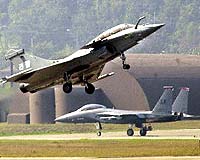| . |  |
. |
Canberra, Australia (UPI) May 13, 2010 Australia will boost spending on its 1,550 troops in Afghanistan by an extra $391 million up to the end of 2011, the defense ministry said. The money, announced as part of the new defense budget, will be for increased fire power and improved rocket-detecting technology mostly for soldiers fighting the Taliban in Afghanistan's dangerous Oruzgan province. The government's shopping list includes upgraded technology to clear roads of dangerous improvised explosive devices, better armor and increased firepower for Bushmaster vehicles, improved body armor for soldiers, new night vision equipment, additional explosives detection dogs and better capabilities for intelligence and reconnaissance work. Defense Minister John Faulkner said the money is part of an $894 million increase to the overall $20.6 billion defense budget announced by the government. The rest of the $894 million will be spent on operations in Middle East, East Timor and the Solomon Islands. By improving security in East Timor Australia could deploy an increasing number of reservists as has already happened in the Solomons mission, Faulkner said. A major purchase will be a new counter rocket, artillery and mortar radar system to detect incoming rockets, artillery and mortars fired at the Australian base at Tarin Kowt, the small isolated capital of Oruzgan province in southern central Afghanistan. C-RAM radar systems use target acquisition sensors to detect and track incoming shells. It is intended to be integrated with firing systems that react to the location of incoming ordnance and then fire outgoing shells along the same trajectory. The U.S. Army selected Northrop Grumman Corp. in October 2004 as the prime contractor to develop a C-RAM system. It uses the AN/TPQ-36 Firefinder radar system produced by Northrop Grumman's Electronic Systems sector. Once a threat is detected, audio and visual alarms warn soldiers. A fire-control subsystem predicts the mortar's flight path, prioritizes targets, activates a warning system and provides cuing data to defeat the mortar round while still in the air. C-RAM doesn't fire solid tungsten penetrators. Instead, self-destructing explosive bullets are used to reduce the risk of civilian and friendly-fire casualties. U.S. and Canadian troops have also operated out of bases they set up in and around Tarin Kowt. It has a population of 10,000 and is noted for being one of the first areas in 2001 where local tribal chiefs rose up against the Taliban and with foreign military help drove them out of town and surrounding hills. The increase in spending for troops was made possible in part by an ongoing major reform to improve defense procurement efficiencies and cuts in operating costs, Faulkner said. This year's defense budget's 3 percent real growth is in line with past years. The $894 million in savings will start with around $3.6 million this year but rising to larger sums in the following years and topping out with around $527 million by 2017.
Share This Article With Planet Earth
Related Links The Military Industrial Complex at SpaceWar.com Learn about the Superpowers of the 21st Century at SpaceWar.com
 Dassault-UAE may team up on Rafale bid
Dassault-UAE may team up on Rafale bidParis (UPI) May 12, 2010 The United Arab Emirates and France are considering teaming up in developing a more capable new generation of Dassault Rafale combat aircraft. The potential project comes hot on the heels of Dassault's designs to delivery upgraded Rafale models to the United Arab Emirates by the end of 2014 following an agreement which aims to be reached by the end of the year. "The conversation ... read more |
|
| The content herein, unless otherwise known to be public domain, are Copyright 1995-2010 - SpaceDaily. AFP and UPI Wire Stories are copyright Agence France-Presse and United Press International. ESA Portal Reports are copyright European Space Agency. All NASA sourced material is public domain. Additional copyrights may apply in whole or part to other bona fide parties. Advertising does not imply endorsement,agreement or approval of any opinions, statements or information provided by SpaceDaily on any Web page published or hosted by SpaceDaily. Privacy Statement |